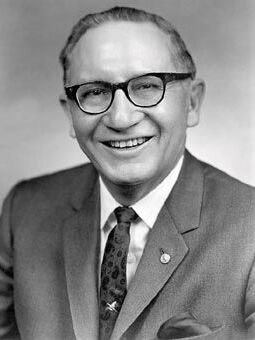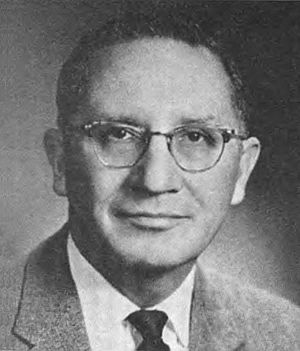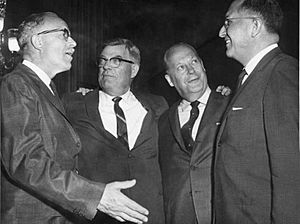Ben Reifel facts for kids
Quick facts for kids
Ben Reifel
|
|
|---|---|
 |
|
| Interim Commissioner of Indian Affairs | |
| In office 1976–1977 |
|
| President | Gerald Ford |
| Preceded by | Morris Thompson |
| Succeeded by | Forrest Gerard (as Asst. Sec. of the Interior for Indian Affairs) |
| Member of the U.S. House of Representatives from South Dakota's 1st district |
|
| In office January 3, 1961 – January 3, 1971 |
|
| Preceded by | George McGovern |
| Succeeded by | Frank E. Denholm |
| Personal details | |
| Born |
Benjamin Reifel (or Lone Feather)
September 19, 1906 Rosebud Indian Reservation, South Dakota, U.S. |
| Died | January 2, 1990 (aged 83) Sioux Falls, South Dakota, U.S. |
| Nationality | Rosebud Lakota United States |
| Political party | Republican |
| Spouses |
|
| Children | Loyce Nadine Reifel |
| Alma mater |
|
| Profession | Federal civil service |
Benjamin Reifel, also known as Lone Feather (born September 19, 1906 – died January 2, 1990), was an important leader from the Lakota Sioux tribe. He worked for the government and later became a politician.
Ben Reifel had a long career with the Bureau of Indian Affairs (BIA). This government agency works with Native American tribes. He eventually became an area administrator.
He made history by becoming the first Lakota person elected to the United States House of Representatives. He served five terms as a Republican Congressman for South Dakota.
Ben Reifel was born on the Rosebud Indian Reservation in South Dakota. He went to South Dakota State University. During World War II, he served in the Army and became a lieutenant colonel.
He worked for the United States Department of the Interior starting in 1933. He retired from the BIA in 1960. He also earned advanced degrees from Harvard University.
Contents
Early Life and Education
Ben Reifel was born in a log cabin near Parmelee, South Dakota. This was on the Rosebud Indian Reservation. His mother, Lucy Burning Breast, was Lakota Sioux. His father, William Reifel, was of German descent.
Ben Reifel was a member of the Rosebud Sioux Tribe. His Lakota name, Lone Feather, means "Lone Feather" in English. As a child, he went to school in Todd County, South Dakota and a boarding school on the Rosebud Reservation. He finished eighth grade at age sixteen. He could speak both English and Lakota.
After school, Ben worked on his family's farm for three years. Then, he attended a vocational high school in Brookings, South Dakota. In 1928, he enrolled at South Dakota State College. He paid for his first four years of college himself. He also took one of the first loans for Native American students. This loan program was suggested by the Merriam Report.
In 1932, he graduated with a degree in agriculture. He was also elected President of the Students' Association in his final year.
Career in Public Service
After graduating in 1932, Ben Reifel worked as an adviser for boys at Hare's School in Mission, South Dakota. In 1933, he started working for the Bureau of Indian Affairs (BIA). His first job was as a farm agent on the Pine Ridge Indian Reservation. He worked with the Oglala Lakota people there. A year later, he became a field agent in Pierre, South Dakota.
His job included telling tribes about the Indian Reorganization Act. This new law, signed by President Franklin D. Roosevelt in 1934, changed how Native American lands were managed. It stopped the division of tribal lands. It also helped tribes create their own governments. They were encouraged to write constitutions and elect leaders.
Native American people faced very hard times during the Great Depression. There was also a severe drought that caused the Dust Bowl. Ben Reifel worked hard to get support for the new Act. He traveled to reservations across South Dakota. He made sure the BIA's programs were helping the tribes.
Military Service in World War II
Ben Reifel's work at the BIA was paused by World War II. He had been a second lieutenant in the United States Army Reserve since 1931. In March 1942, the Army called him to active duty. He served until July 1946. He was promoted to the rank of lieutenant colonel.
After the War
After leaving the Army, Ben Reifel returned to the BIA. He became a Tribal Relations Officer. Later, he was promoted to Superintendent of the Fort Berthold Indian Reservation in North Dakota.
Studying at Harvard
In 1949, Ben Reifel received a special scholarship. He went to Harvard University to study public administration. This was part of a program for government officials. He earned his master's degree in 1949. He then received another fellowship and completed his PhD in Public Administration in 1952.
After his studies, Ben Reifel went back to the BIA. He worked briefly in Washington, D.C.. Then, he returned to the Fort Berthold Indian Reservation as Superintendent. He also served as Superintendent at the Pine Ridge Indian Reservation.
In 1955, he became the Area Director of the Aberdeen Area Office in Aberdeen, South Dakota. He was in charge of many employees and federal programs for Native Americans. This covered a three-state area: Nebraska, North Dakota, and South Dakota. He held this position until three years before he retired.
Political Career
In 1960, Ben Reifel retired from the BIA. He decided to run for Congress in South Dakota's 1st congressional district. This district included all the counties east of the Missouri River. He won the election by a large amount. He was the first person of Lakota or Sioux descent to serve in the U.S. Congress. During the 1960s, he was the only American Indian in Congress.
He served five terms as a Representative for South Dakota. He was known as a "conservative Republican." He was a thoughtful person who studied issues carefully. He always had good reasons for his opinions on laws.
In Congress, Ben Reifel worked on several committees. In his first term, he joined the House Agricultural Committee. In his second term, he moved to the House Committee on Appropriations. He was the top Republican on the subcommittee for Interior Department Affairs.
He worked hard for farmers in South Dakota and the Plains states. He opposed cuts to farm support programs. He also pushed for the Oahe Dam to provide water for irrigation.
He also continued to work strongly for Native American education. He believed that ending the isolation of Native American people was important. He thought that Native American and non-Native American students should learn together. This meant using modern schools instead of only Indian boarding schools. This idea was also suggested by the 1928 Merriam Report. Ben Reifel supported the Civil Rights Act of 1968. He also supported increasing the minimum wage.
Ben Reifel helped get the Center for Earth Resources Observation and Science (EROS) located in South Dakota. This center is part of the U.S. Geological Survey. He also helped keep Ellsworth Air Force Base active in the state. On a national level, he helped pass laws to create the National Endowment for the Humanities and the National Arts Council.
In 1970, Ben Reifel decided not to run for re-election. He planned to retire in 1971. However, he remained active in public service. President Richard Nixon appointed him to lead the National Capital Planning Commission. This group oversees federal projects in the Washington, D.C. area. He then became a Special Assistant for Indian programs. This was for the Director of the National Park Service. He also served as Interim Commissioner of Indian Affairs. This was during the last two months of the Ford administration.
Later Years and Legacy
In the 1960s and 1970s, Ben Reifel was a member of several groups. These included the Masons, Rotarians, and Elks. He also served on the National Council of the Protestant Episcopal Church. He was also on the National Council of the Boy Scouts of America. He was the national president of Arrow, Inc., a service group for Native Americans.
In 1977, Ben Reifel became a trustee of the South Dakota Art Museum in Brookings. He was the board president in 1982–83. He started the first Native American art collection at the museum in 1977. He donated most of his own collection.
Honors and Awards
- 1956: Received the Outstanding American Indian Award.
- 1960: Awarded the Annual Indian Achievement Award.
- 1960: Received the Silver Antelope Award from the Boy Scouts of America. He also received the Gray Wolf, Silver Buffalo, and Silver Beaver Awards in Scouting.
- 1961: Received the Distinguished Service Award from the United States Department of the Interior. This was for his work with the BIA.
- The Ben Reifel Visitor Center in Badlands National Park is named after him.
- He received honorary doctorates from South Dakota State University, the University of South Dakota, and Northern State College.
- A dorm at South Dakota State University was named after him and opened in 2015.
- In 2018, a new middle school in the Sioux Falls School District was named after him.
Family Life
On December 26, 1933, Ben Reifel married Alice Janet Johnson. She was his college sweetheart from Erwin, South Dakota. They had one daughter, Loyce Nadine Reifel. Loyce later married Emery Andersen. Alice Reifel passed away from pneumonia on February 8, 1972.
Ben Reifel married Frances Colby on August 14, 1972. She was from DeSmet, South Dakota. Ben Reifel died from cancer on January 2, 1990.
See also



